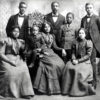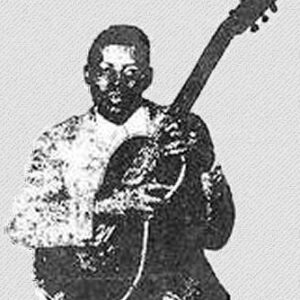calsfoundation@cals.org
Casey Bill Weldon (1901?–1972?)
Casey Bill Weldon was one of the most talented, yet enigmatic, blues slide guitarists of the early twentieth century. Known as the “Hawaiian Guitar Wizard,” Weldon exhibited a range of material encompassing rag, hokum, and blues, though the majority of his more than 100 recorded songs are considered blues. Though he had a solid body of recordings and played with some well-known performers and bands of his day, much of his life is still shrouded in mystery.
Casey Bill Weldon was born on February 2, 1901, in Pine Bluff (Jefferson County), according to blues legend Big Bill Broonzy; some sources list his birthdate as July 10, 1909. Little is known of his youth, but as a young man he eventually moved to Memphis, Tennessee. Weldon expertly played slide-guitar style on a National steel guitar and has been cited by several blues historians as an influential force in the early development of this style. He is known to have joined the famous Memphis Jug Band in the 1920s and is assumed to be the same person as the Will Weldon who recorded with that band for Victor Records in 1927 and 1928. He also played for the Brown Bombers of Swing.
Much controversy exists over the longstanding claims of Broonzy and British researcher Mike Leadbitter that the legendary Memphis Minnie and Weldon were married in the 1920s. While the two recorded together for Bluebird Records in 1935, there is sparse evidence that they ever wed.
From 1935 to 1938, Weldon is known to have recorded extensively. During this period, he wrote and recorded three songs that are blues staples, including “Somebody’s Got to Go,” “Somebody Changed the Lock on My Door,” and “We Gonna Move on the Outskirts of Town.”
Weldon is known to have recorded with other great artists of his day, including Broonzy, Tampa Red, Ollie Rupert, Leroy Henderson, Arnett Nelson, Charlie and Joe McCoy, Amos Easton (also known as Bumble Bee Slim), Blind Teddy Darby, the Hokum Boys, the Brown Bombers of Swing, Washboard Sam, and Peetie Wheatstraw.
After 1938, details of Weldon’s career become murky. He is said to have performed using an electrically amplified guitar in 1941. It has also been asserted that he moved to Los Angeles, California, sometime after the early 1940s, providing incidental music for film soundtracks. Around 1960, guitarist Ted Bogan stated that he ran into Weldon in Chicago, Illinois, where Weldon claimed that he had given up music and was doing other work.
The place where Weldon died has long been a mystery, but blues historian Jim O’Neal uncovered information suggesting that Weldon died on September 28, 1972, and is buried in Lincoln Cemetery in Kansas City, Missouri. Various documents indicated that Weldon had two legal names, William Weldon and Nathan Hammond, and that he may have employed a variety of other names, in addition to claiming an array of birthplaces, including Plumerville (Conway County).
For additional information:
Birnbaum, Larry. Before Elvis: The Prehistory of ‘n’ Roll. Lanham, MD: Scarecrow Press, 2012.
Bogdanov, Vladimir, Chris Woodstra, and Stephen Thomas Erlewine, eds. All Music Guide to the Blues: The Definitive Guide to the Blues. Montclair, NJ: Backbeat Books, 2003.
“Casey Bill Weldon.” AllMusic.com http://www.allmusic.com/artist/casey-bill-weldon-mn0000191648 (accessed September 29, 2021).
Herzhaft, Gerard. Encyclopedia of the Blues. Fayetteville: University of Arkansas Press, 1997.
O’Neal, Jim. “Unraveling Casey Bill Weldon.” Living Blues (December 2013): 72–77.
Jimmy Cunningham
Nashville, Tennessee
 African Americans
African Americans Early Twentieth Century, 1901 through 1940
Early Twentieth Century, 1901 through 1940 Music and Musicians
Music and Musicians Casey Bill Weldon
Casey Bill Weldon 




Comments
No comments on this entry yet.